Corn Grading Procedures: Part 3
Test Weight per Bushel.
Test weight per bushel is the weight of the volume of grain that is required to fill a Winchester bushel (2,150.42 cubic inch) to capacity. Since test weight per bushel tends to increase as moisture content decreases, determine it as quickly as possible after the grain is sampled. Determine test weight per bushel before the removal of BCFM. Several devices may be used to determine test weight per bushel; all of these devices operate in a similar manner.
Step 1. Pour the sample through a funnel into a kettle until the grain overflows the kettle.
Step 2. After pouring the grain into the kettle, level it off by making three, full-length, zigzag motions with a stroker.
Step 3. Then weigh the filled kettle on either (1) a special beam scale attached to the funnel stand, (2) an electronic scale programmed to convert gram weight to test weight per bushel, or (3) a standard laboratory scale. If a standard laboratory scale is used, the gram weight must be manually converted to test weight per bushel by using a special conversion chart. This will be recorded on the work record and the certificate to the nearest tenth pound per bushel. For example, 54.32 will be recorded as 54.3.
Procedures for Determining Foreign Material and Broken Corn (BCFM) with Hand Sieves.
Step 1. Nest the appropriate sieve(s) on top of a bottom pan. Use a 12/64-inch round-hole sieve.
Step 2. Pour a sample portion (250 grams) into the center of the top sieve.
Step 3. Place the sieve(s) in a mechanical grain sizer, set the sizer's timer to 20, and turn it on. If a mechanical sizer is not available, hold the sieves and bottom pan level, and, using a steady motion, move the sieve from right to left approximately 10 inches. Return from left to right to complete one sieving operation. Repeat this operation 20 times.
Step 4. Consider BCFM to be all material that passed through the 12/64-inch round-hole sieve and all material 'other than corn' that remains on top of the sieve. 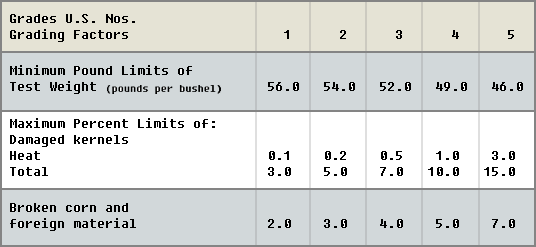
U.S. Sample grade
U.S. Sample grade is corn that:
(a) Does not meet the requirements for U.S. Nos. 1, 2, 3, 4, or 5; or
(b) Contains stones that have an aggregate weight in excess of 0.10 percent of the sample weight, 2 or more pieces
of glass, 3 or more crotalaria seeds (Crotalaria spp.), 2 or more castor beans (Ricinus communis L.), 4 or more
particles of an unknown foreign substance(s) or a commonly recognized harmful or toxic substance(s), 8 or
more cockleburs (Xanthium spp.) or similar seeds singly or in combination, or animal filth in excess of 0.20
percent in 1000 grams; or
(c) Has a musty, sour, or commercially objectionable foreign odor; or
(d) Is heating or of distinctly low quality.
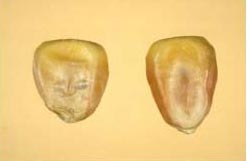
A germ affected with blue eye mold (regardless of size of the mold), is a damaged kernel. If mold is distinct, it is not necessary to open or scrape kernel. If opening is necessary, lift germ cover carefully to avoid destroying evidence of mold. Note: Do not confuse blue eye mold with purple plumules.
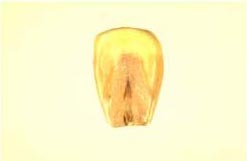
Kernels of corn that have been damaged by respiration or heat, but that are not materially discolored, shall be considered damaged. See procedure for details and interpretation guidelines. Procedure:
1. Those kernels requiring close examination should be carefully opened so as to remove only the seed coat over the germ area. Scraping too deeply can destroy the evidence of damage and cause nonuniformity of interpretation.
2. Kernels should be opened with a sharp instrument, such as a pair of picks or a knife.
3. Observe the entire germ area when determining if the kernel is dark or darker than the kernel shown on the slide.
4. Germs that have more intense partial discoloration require less coverage of the germ area in order to be considered damaged.
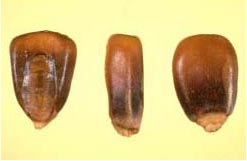
Kernels that are materially discolored by excessive respiration, with the discoloration extending out of the germ, around the sides and across the back of the kernel.
Kernel 1: Shows the discoloration extending out of the germ.
Kernel 2: Shows the discoloration around the sides.
Kernel 3: Shows the discoloration across the back.
Note: Kernels that meet these conditions are considered heat damage. For heat damage (dryer) and heat damage in white corn refer to Interpertative Line Slide C-5.0 and C-5.1 respectively.
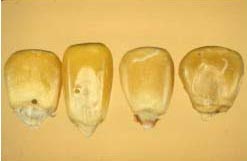
Kernels with obvious weevil-bored holes or that have evidence of boring or tunneling (tracings) indicating the possible inner presence of insects, insect webbing or insect refuse.
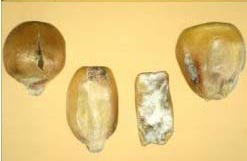
Whole or broken kernels that contain any amount of mold on the exposed part of the kernel are considered damaged. Note: Do not confuse mold with dirt. Mold occurs in many colors.




